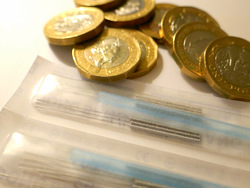 American researchers say acupuncture helps diabetic peripheral neuropathy, and is a valuable adjunctive treatment for low income and marginalised sections of society. In a 12 week randomised trial, 40 patients, mean age 59, were recruited from outpatient clinics at the Zuckerberg San Francisco General Hospital and Trauma Center, an urban public hospital serving diverse patients (70% racial/ethnic minorities). In-depth qualitative interviews were conducted with a subset of 17 participants.
American researchers say acupuncture helps diabetic peripheral neuropathy, and is a valuable adjunctive treatment for low income and marginalised sections of society. In a 12 week randomised trial, 40 patients, mean age 59, were recruited from outpatient clinics at the Zuckerberg San Francisco General Hospital and Trauma Center, an urban public hospital serving diverse patients (70% racial/ethnic minorities). In-depth qualitative interviews were conducted with a subset of 17 participants.
Patients randomised to receive acupuncture reported greater decreases in pain compared with usual care, and improvements in quality of life. There was also reduced reliance on analgesics, improved sleep and daily function, reduced stress, and improved engagement with their own self-care.
The authors say,”Overall, participants found acupuncture beneficial for a range of symptoms common with PDN, including burning or aching pain, sensations of heat or cold, or numbness. This diversity of presentations partially explains why conventional treatments such as pain medications have limited efficacy in treating this condition. Acupuncture may hold unique promise as a treatment for PDN because of its potential to address patients’ multifaceted pain experience, including physical symptoms as well as psychological well-being.”
(“It Gave Me Hope” Experiences of Diverse Safety Net Patients in a Group Acupuncture Intervention for Painful Diabetic Neuropathy. Health Equity, online 22 May 2020.)

 Acupuncture helps trigeminal neuralgia, and appears a more effective, safer and cheaper option compared with either drugs or surgery, according to research by the School of Medical Sciences, Bangor University. They surveyed 17 studies comparing the drug carbamazepine, with microvascular decompression surgery, and with acupuncture.
Acupuncture helps trigeminal neuralgia, and appears a more effective, safer and cheaper option compared with either drugs or surgery, according to research by the School of Medical Sciences, Bangor University. They surveyed 17 studies comparing the drug carbamazepine, with microvascular decompression surgery, and with acupuncture. 
 American researchers have shown electroacupuncture significantly reduces pain after kidney stone removal by percutaneous nephrolithotomy. They randomised 51 patients to receive either electroacupuncture, sham electroacupuncture or no acupuncture. Flank and abdomen pain was lower at all time points in the electroacupuncture group compared with the other two groups. Immediate post-operative opioid use was also lower in the electroacupuncture group, with two patients not requiring any opioids.
American researchers have shown electroacupuncture significantly reduces pain after kidney stone removal by percutaneous nephrolithotomy. They randomised 51 patients to receive either electroacupuncture, sham electroacupuncture or no acupuncture. Flank and abdomen pain was lower at all time points in the electroacupuncture group compared with the other two groups. Immediate post-operative opioid use was also lower in the electroacupuncture group, with two patients not requiring any opioids.